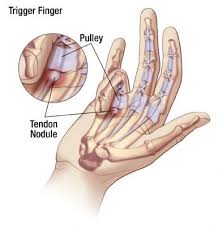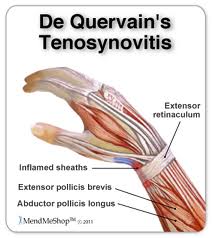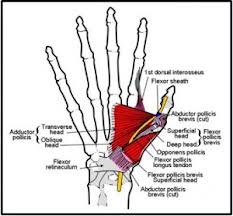Written by Debbie on December 26, 2013 |

Do you have a trigger? It creeps up on you slowly. With time, it suddenly locks, and then straightens with a snap – like a trigger being pulled and released. What is a “trigger finger”? It is a condition that affects the tendons and the pulleysin your fingers or your thumb.
Tendons are tissues that connect muscles to bone. In the finger, the pulleys are a series of rings that form a tunnel through which the tendons glide, much like the guides on a fishing rod through which the line (or tendon) must pass. The tendons and the tunnel have a lining that allows easy gliding of the tendon through the pulley.(1)
Continue Reading »
Written by Debbie on December 18, 2013 |

Persistent symptoms of pain along the thumb especially and including at the level of the wrist during texting can lead to a repetitive overuse injury. One such diagnosis is DeQuervain’s Tenosynovitis, also known as DeQuervain’s Syndrome.
Tenosynovitis is defined as the inflammation of the fluid-filled sheath that surrounds a tendon. DeQuervains’ Syndrome is a tenosynovitis of the sheath or tunnel that surrounds two tendons that control movement of the thumb.It is named after the Swiss surgeon Fritzde Quervain, who first identified it in 1895.
Continue Reading »
Written by Debbie on December 6, 2013 |

Cell phones, and particularly smart phones, have added to our connectedness through mobile data, cellular emails and especially the text message. Our thumbs are on overdrive as we communicate and interact through our phones. According to Pew Research, 9.8 trillion text messages were sent in 2012.
The tendons and muscles of the thumb are strong but not designed to do intense repetitive activity in cramped positions while on a handheld device or cell phone. The traveling of the thumb tip over the keypad causes undue stress over a period of time. The muscle fatigue, strain and prolonged muscle tension can lead to pain and inflammation that affects thumb flexibility and use. It can eventually cause tendinitis or tenosynovitis, inflammation of the tendon. If untreated, it can lead to a more serious problem of affecting everyday use of your thumb.
It may start as an ache at the base of your thumb, between your thumb and index finger, and include your wrist. It may notice it after you text or during the activity as it progresses.
If you start to feel pain, take a break. Use the other hand or digit. Make a phone call instead. Don’t text for more than a few minutes at a time. Don’t text long sentences. Use yes or no replies when you can. Spread out the activity throughout your day.
You can do gentle massage and thumb stretches to alleviate the muscle tension. It will improve flexibility and reduce discomfort. Reducing muscle tension will minimize stress on the tendons, thus hopefully avoiding tendinitis.
If symptoms persist, you may want to make an appointment to see your physician. Persistent pain and inflammation can lead to tendinitis or tenosynovitis. One common diagnosis with texting thumb is called DeQuervain’s Tenosynovitis. See next week’s article for addressing this diagnosis, and what you need to know, and can do to treat these symptoms unfortunately on the rise with thumb texting.




